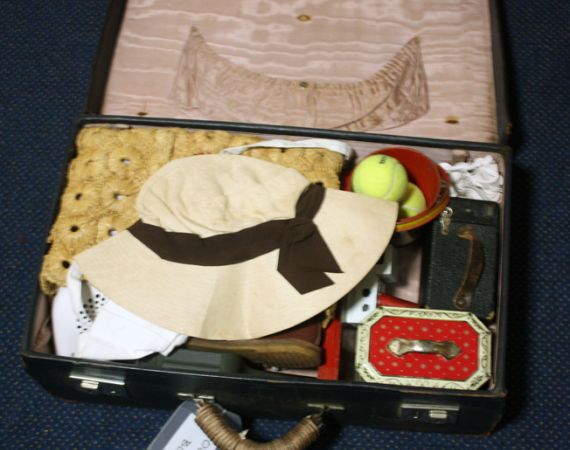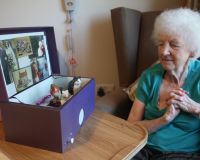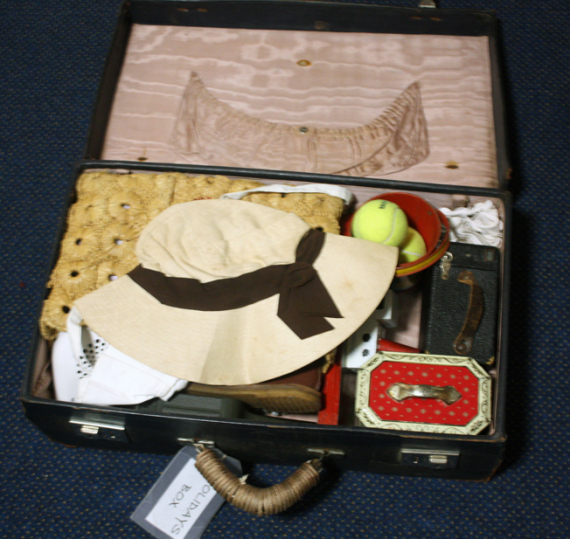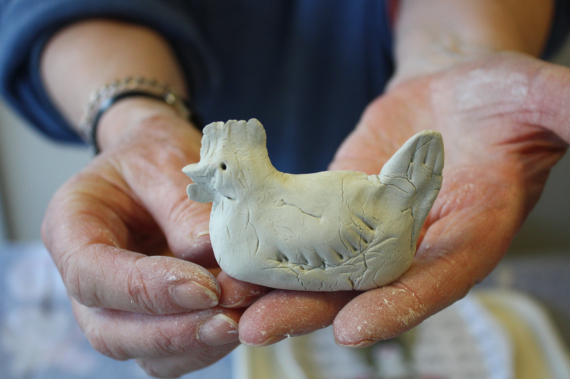Posted on Thu 26 May 2016
Community Collaboration
One of my main aims of the residency was to get the community involved in developing the Music Memory Box:Day Centre

Posted by
Project

Music Memory Box
Music Memory Box harnesses the evocative power of music to create a tool for people living with dementia to recollect, reminisce and reconnect with loved ones.One of my main aims of the residency was to get the community involved in developing the Music Memory Box:
Day Centre
I have run four sessions in the day centre so far. In the first session I introduced myself and what I will be trying to achieve whilst working with them. It is a large group of around thirty people. The second and third session were all about developing an understanding of each persons music tastes, what songs made them laugh, sing, dance and unfortunately cry. Starting from general eras, I now have a song for most of the people I am working with. The fourth session I did, I themed as it was sunny that day, ‘Holidays by the sea’. I borrowed a suitcase of seaside/holiday related objects from Helston Folk Museum. I played pier music and unpacked the suitcase. I handed the objects out and we talked about what they were, whether anyone had owned any of these objects and whether it sparked any memories. I learnt a lot in this session as some objects, for example, a brownish blackish box with a strap on; I did not know was a Brownie Box Camera. Intergenerational projects definitely work and are successful, as the people I work with seem to relish the fact I am young and they are wise, but also were asking me about the holidays I’d been on and objects that I would take on holiday with me.

I have learnt a huge amount from these sessions, firstly how great the range of age groups of people there are in a certain care scenario, and therefore a range of eras that they will be interested in. You cannot assume that everyone has lived in Cornwall, some have moved down here in the last year, so they would not know Cornish folk songs. Some have lived in Cornwall their whole lives and are proud of this, so prefer to listen to Cornish folk songs. Many sessions offered at the moment are very stereotypical in their view of the type of person they are trying to design around. For example, playing Vera Lynn and looking through a box of WW1 objects may suit some, but for others this will not stimulate them at all as they have no earlier memories to recall. The youngest people in the setting may want to listen to Queen and Gerry and the Pacemakers, where some people on the other side of the room may have never heard these songs before. This provides a good opportunity to enhance communication with others and find out new stories about each other. The objects in particular add a new way of communication, through tactility, which is important when it is difficult to interact with someone through speech. Holding, opening, playing with objects can stimulate memories, recollections and emotions too.
My initial aim was to make objects with each person that related to the piece of music or story that the music promoted. Through my hands on research, I have learnt that for the communal boxes’ it is more a question of promoting identity. At a time, when a person’s identity can become cloudy and confused, it is important to support and promote someone’s feelings of their own identity. What did they used to love to do? Gardening, making, singing, sailing? The object that sets off their individual piece of music, becomes an object I hope they identify themselves with. When they pick up their object and play with it in their hands and listen to the piece of music or recording I hope this strengthens connections in their mind, and strengthens their outward connections and connects them with where they are today. I am not sure if this can achieved in a single object and piece of music, but I have a month left to try.
One lady who I've been working with is probably, from my untrained eye, the most effected by dementia that I have met. She sees mysterious visions that can sometimes be quite upsetting and unsettling. I find it really hard to talk to her, so I usually just grin at her from time to time, I thought she was the least interested in the music, sometimes she will smile at some songs, but that is all. I didn't think she recognised me each time I've come in, however the last session I did, she told me that she liked me coming along and playing lovely music and showing her treasures and that it made her happy.
Jennifer Grierson & Memory Cafe
Jennifer Grierson, is another collaborator I have been working alongside. Jennifer has many years experience of working in arts therapy, and it is great to have someone so knowledgeable to help me. We did a joint session at a Memory Café involving making something with their hands, and listening to music that related to the activity. At the end of the session we had a good starting point for further work as we had a sort of mind map on each person, what they loved to smell, hear, see, touch and taste. We took part in our own session too, as it is important not to segregate, everyone benefitted from the session including myself.
Jennifer Grierson & Sheltered Housing
Jennifer and I have different outcomes we want to achieve through our sessions, but have been teaming up so we both can develop our projects further, our time scales are a bit different as I have only a month left, where Jennifer’s work will be ongoing. She has also helped me, with material experimentation. We did a small workshop in a sheltered housing unit, where we all tried to make the object we had in mind relating to our piece of music and the story that we were trying to recall, out of three different materials:
Firstly Sugru: Although not initially designed for modelling I thought we should give it a go, the smell was horrible and the modelling was difficult, and it starts to sag as it dries so this was scrapped immediately. Secondly salt dough, we thought this might be good as it is a reminiscing material in itself as many people when they are children make Christmas decorations out of it. We then tried some experimental baking, with RFID tags embedded in our salt dough shapes, we stuck them in a residents microwave to see if they exploded or not. We all enjoyed the suspense of this experimental hacking! And finally we tried Fimo air drying clay, this felt the nicest in the hands, was easily manipulated if someone has dexterity issues and when dry seemed the most stable. Both salt dough and Fimo worked well. The material used in future boxes with the ‘make your own objects’ choice will be dependant on cost, whether there is a microwave and whether people can wait 24 hours for the Fimo to dry or they want an instant result by popping it in the microwave.

Through my work within the community I have understood where my projects sits in different scenarios and how it can develop to be more useful. To develop friendships and trust in three months with people I am asking personal questions to is also difficult. This is a thought that needs more discussion in another post, about how the project can be scalable. I aim to make something physical for the day centre, the memory café and the sheltered housing unit before I leave, so I can test run these boxes. The technical issues that come up, can help steer the design of the box, system and distribution of future boxes.
